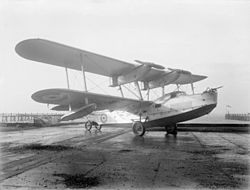Supermarine Scapa
| Supermarine Scapa | |
|---|---|

|
|
| Type: | Flying boat |
| Design country: | |
| Manufacturer: | |
| First flight: |
July 8, 1932 |
| Commissioning: |
1935 |
| Number of pieces: |
15th |
The Supermarine Scapa was a British reconnaissance flying boat . The flying boat, built by the Supermarine company , was used by the Royal Air Force between 1935 and 1939 . It was a further development of the Supermarine Southampton and formed the basis for the later development of the Supermarine Stranraer .
development
After the chief designer of Supermarine, RJ Mitchell , had already experimented with some three-engine flying boats like the Supermarine Nanuk , the Solent and the Southampton X , he decided to use the good hydrodynamic design of the twin-engine Southampton as a base for a new aircraft.
Under the name Southampton IV one was a prototype built. In tests in the water basin, the lower hull performed better. In November 1931, the Air Ministry issued a corresponding tender. Test pilot "Mutt" Summers completed the first flight with this aircraft on July 8, 1932. Then the name of the aircraft was changed to "Scapa".
After 15 Scapa flying boats had been built, production was switched to the more powerful Stranraer .
construction
The Scapa had a metal hull. The wings and tail unit each consisted of a fabric-covered metal grid construction. The engines were housed in nacelles below the upper wing. The aircraft had a double vertical tail, which was attached in the middle of the horizontal stabilizer. As with the Southampton, the Scapa also had three defenses, one in the front of the bow and two more on the back of the fuselage.
operator
-
 United Kingdom
United Kingdom
- No. 202 Squadron RAF
- No. 204 Squadron RAF
- No. 228 Squadron RAF
- No. 240 Squadron RAF
Technical specifications
| Parameter | Data |
|---|---|
| crew | 5 |
| length | 16.20 m |
| span | 22.85 m |
| height | 6.4 m |
| Wing area | 121 m² |
| Empty mass | 4500 kg |
| Max. Takeoff mass | 7290 kg |
| Top speed | 229 km / h |
| Service ceiling | 4720 m |
| Range | 1610 km |
| Engines | 2 × Rolls-Royce Kestrel IIIMS with 392 kW (533 PS) |
| Armament | 3 x 7.7 mm Lewis Guns ; one in the bow, two on the back of the fuselage 453 kg bomb load under the wings |
See also
Web links
Individual evidence
- ↑ CF Andrews, Morgan, EB: Supermarine Aircraft since 1914 ( English ), 2nd. Edition, Putnam, London 1987, ISBN 0-85177-800-3 .
